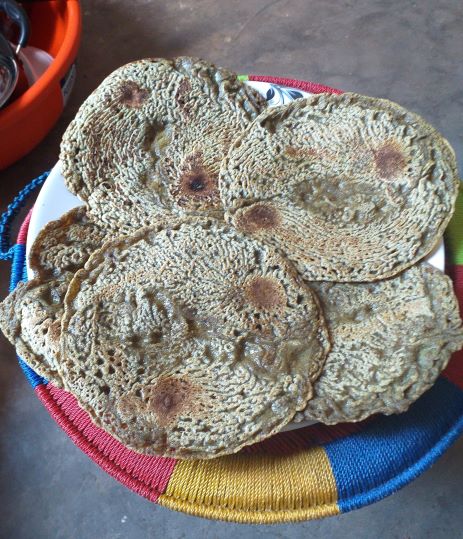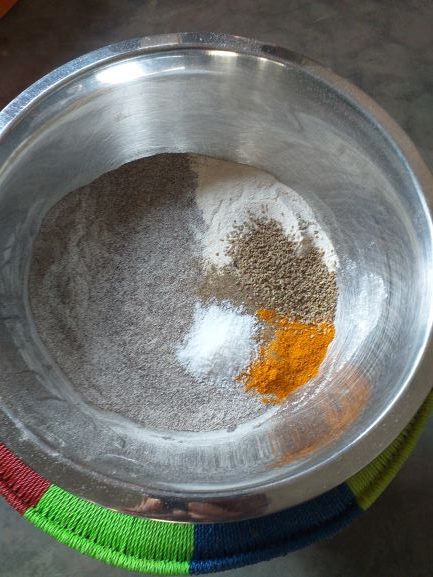A question for an urbanite: What do you have for breakfast when there are no crusty loaves from the oven, overnight oatmeal or fruit, steamed pao, or dare we utter the ultimate that, that distinguishes a Malaysian from all others – nasi lemak?
The answer that transpires from the modest hills overlooking the abode of snow: dish out Kodo Ko roti.
Everyday. Fresh from the skillet because that’s all we have during a pandemic. Kodo flour is milled from the village mill, a brief 3 mins walk from the kitchen and is cooked with copious amounts of glorious ghee, compliments from Madam Buffalo and Madam Cow.
Part of the millet family, Kodo Ko roti as it is called here is rather like pancakes that can be whisked up in a matter of minutes. As versatile as it’s flat counterpart, it can be battered up in a variety of ways, as far as imagination takes. Although barred with the basics at the moment, there is potential in experimenting with various flours like chickpea, black gram and buckwheat, fused with grated carrots and beetroot and a handful of seeds, coconut, herbs and spices.




A staple in the hills and mountains of Nepal, kodo is a storehouse of nutrients. It is a very hardy crop that is drought tolerant and can survive on marginal soils. Also known as cow grass that grows to heights of approximately four feet, it has a shallow root system which is ideal for inter-cropping between corn and paddy.
A hefty breakfast in its own right, the proportions in this recipe should be sufficient to make 4 sizeable rotis:
- 3/4 cup kodo flour
- 3/4 cup wholemeal flour
- 1 teaspoon jwano seeds (carom seeds)
- 1 teaspoon sesame seeds
- 1 teaspoon dried rosemary
- 1/4 tsp turmeric powder
- 1/4 tsp black pepper
- 1/2 teaspoon salt
Mix the dry ingredients together. Add water or milk till consistency is similar to crepes. This will allow a thinner, crispier roti. Heat up the skillet. Add ghee. Pour a ladle of the batter once its hot enough. Be sure to take the pan off the stove while pouring and swirl the batter around. Flip it. Once bubbles appear and the edges curls up, it’s done.


Serve hot with honey or peanut butter and bananas for a sweet treat. Equally delicious with tomato chutney or mint or coriander chutney. Our host here serves them with aloo masala, potatoes cooked with capsicum, tomatoes and spices.
Tomato Chutney with Bhang (local hempseed)
- 8 large tomatoes
- 1 inch ginger, minced
- 1/2 tsp fenugreek or cumin seeds
- 2 tbsp toasted, ground bhang
- 1/2 tsp turmeric
- Handful of fresh coriander leaves
- 3/4 tsp salt
Fry the seeds in hot oil first till they pop. Add minced ginger till brown. Add the diced tomatoes and cook for about 5 minutes till it breaks down into a thick paste. Then, the turmeric and salt to taste. Finally, finish it off with a generous amount of bhang and fresh coriander leaves.
Mint Chutney with Peanuts
- A large handful of mint leaves
- 1 inch ginger
- 2 limes, juiced
- 4 tbsp toasted, ground peanuts
- 1 tbsp honey
- salt to taste
Making rotis is also about the act of bending, twisting and whipping. Not much is needed. A little courage to try, a few hungry tummies and a makeshift kitchen. We have been churning out 3 meals a day in a converted bedroom with a DIY setup.
A black tube intrudes from the top of a window to get water flowing into a tap and a paint bucket perched at the bottom to collect greywater from under the sink. This is a commendable way to measure how much water is consumed daily from having to empty the bucket a good number of times, and knowing that all those years of practising ‘ashtanga’ has its practical benefits. Another tube connected to the gas tank placed outside the walls slides in from the bottom of the window to pump our stove. Blue plastic bin liners taped up around the stove and sink act as a backsplash to protect the walls. A multi-purpose low table sits in the centre of the room. This is where we prep our food, eat our meals, work, play Monopoly and chess, and discuss all manners and blog. It certainly isn’t an ideal setup but it works and we are eating sufficiently.
Anything goes in this part of the world.



iiling@cloudsontour.com
9 Apr 2020It is way better! Especially with home produced ingredients.
Li Yen
9 Apr 2020Does it taste like the millet chapati in Ganga Cafe?